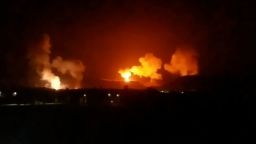Editor’s Note: Dr. Hassan Shahidi is president and CEO of the Flight Safety Foundation. The views expressed here are his own. Read more opinion on CNN.
With no reported fatal accidents involving large commercial jets in scheduled service, 2023 has been widely hailed as one of the safest years in the history of aviation. And the air transport system is safe.

But the aviation system and its safety margins are showing signs of stress. In the United States, there were nearly two dozen serious runway incursions in 2023, up from 16 the previous year. Thankfully, none of those events ended in a fatal accident.
However, tragedy did strike last week when a Japan Airlines Airbus A350 collided with a much smaller Japan coast guard aircraft on a runway at Tokyo’s Haneda Airport. All 379 passengers and crew on the airliner escaped due largely to the professionalism and training of the crew, but five of the six people on board the coast guard aircraft were killed.
Just a few days later, an Alaska Airlines Boeing 737 Max 9 made an emergency landing in Portland, Oregon, after a door plug blew out of the fuselage shortly after takeoff, causing rapid depressurization of the passenger cabin. No serious injuries were reported.

These recent events serve as critical reminders of the dynamic and evolving nature of the aviation system, where constant vigilance and continuous improvement are essential to maintain the highest levels of safety and public trust. Both regulators and the aviation industry must heed the recent warning signs and recommit to maintaining the highest standards and quality to build an even more resilient aviation system.
Perhaps most urgent is staffing. As air traffic has rebounded from the downturn caused by the Covid-19 pandemic, the aviation industry continues to face a significant challenge: the departure of thousands of trained and experienced professionals, such as pilots, maintenance technicians, air traffic controllers and other safety-critical personnel. This exodus, which largely stems from retirements, has led to a significant turnover in the aviation workforce, which is particularly concerning given that achieving the highest levels of safety requires qualified and trained personnel. Aviation stakeholders, including airlines and the Federal Aviation Administration, must focus on recruiting and effectively training new personnel. That will help to relieve pressure on existing staff and (eventually) make up for the lost expertise.
Also important is the adoption of systems that enhance pilot and air traffic controller situational awareness — especially on airport surfaces like runways and taxiways — and build additional layers of safety in an environment that is increasingly complex. These systems include cockpit-based displays that provide pilots with timely alerting to potential hazards. Similarly, for air traffic controllers, radar-based technologies, such as those installed at some busy airports in the US, provide a significantly improved picture of aircraft movement on runways, taxiways and ramps, especially in low visibility conditions. Some of the advanced capabilities, particularly those designed for air traffic controllers, could be deployed more widely if funds were allocated by Congress. For cockpit-based systems, the standards have been slow to mature.
Lastly, better safety data analysis and information sharing across the aviation community can proactively identify potential risks that might lead to safety incidents. These are indicators that, while not causing direct harm, can signal potential risks or vulnerabilities that might lead to safety incidents if unaddressed. Examples include altitude deviations, patterns of pilot and controller fatigue and equipment and part wear and tear. This data enables airlines, regulators, manufacturers and other industry stakeholders to respond swiftly to new potential safety issues. This cooperative approach ultimately fosters a more effective safety culture within the aviation industry.
We stand at an inflection point in the evolution of aviation safety, poised to elevate it to unprecedented levels. The confluence of technological innovation, commitment to the highest levels of quality, deeper understanding of human factors and a collaborative safety culture marks a unique opportunity to redefine what safety means in the skies, to push the boundaries of what we have achieved so far. By harnessing the collective expertise, commitment and vision of the entire aviation community, we can propel aviation safety into a new paradigm, where continuous improvement and adaptability are not just ideals, but practical realities.
This moment is not just about maintaining our impressive safety record; it’s about envisioning and creating a future where aviation safety is more resilient, more intuitive and more integrated than ever before.
With leadership and working together, the aviation community can make an already safe system even safer.




